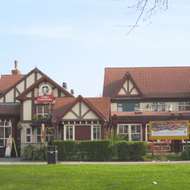Mitchells & Butlers: Navigating Challenges with Strength and Strategy
Posted by Emma on 3rd Dec 2023 Reading Time:
In a landscape where independent pubs grapple with soaring costs and survival challenges, Mitchells & Butlers stands as a beacon of resilience and market outperformance. The renowned entity behind popular brands like Toby Carvery and Harvester is leveraging its considerable scale to navigate challenging times more effectively than many competitors.
 Simon Cobb, CC0, via Wikimedia Commons
Simon Cobb, CC0, via Wikimedia Commons
Phil Urban, the Chief Executive of Mitchells & Butlers, proudly announced the company's robust trading performance, which he described as a testament to its "resilience in the face of unprecedented headwinds". This statement came in light of their full-year results, which surpassed expectations set by financial experts. Urban highlighted the group's success in recording like-for-like sales growth across all brands, marking a record outperformance in the wider pub market. Particularly noteworthy was Nicholson's, a drink-led brand, which soared thanks to the resurgence of office workers and tourists in city centres. On the food-led front, Toby Carvery was the standout performer.
Tracing its origins to a demerger from the old Bass brewing empire in 2003, Mitchells & Butlers now boasts approximately 1,760 venues under various brands, including Miller & Carter and Ember Inns. Odyzean Group, a consortium of prominent sporting figures, holds a significant majority stake in the company.
Urban touched upon the company's dividend policy, indicating no immediate plans for restoration – a strategy supported by the consortium. His focus remains on reducing debt while growing profits, suggesting dividends might not be considered for the next two to three years.
 Stevenage: Harvester restaurant "Roaring Meg" by Michael Garlick, CC BY-SA 2.0, via Wikimedia Commons
Stevenage: Harvester restaurant "Roaring Meg" by Michael Garlick, CC BY-SA 2.0, via Wikimedia Commons
The financial figures paint a picture of resilience and strategic manoeuvring. The year ending in September saw like-for-like sales growth of 9.1%, with total revenue jumping from £2.2 billion to £2.5 billion. Although the adjusted operating profit slightly declined, the figures were still ahead of expectations. A noteworthy shift was observed in their pre-tax profits, turning from a profit of £8 million to a loss of £13 million. However, the reduction in net debt from £1.2 billion to £1.17 billion signals a solid financial footing.
Continuing this trajectory post-financial year, the company reported a robust 7.2% growth in like-for-like sales. Despite the 9.8% rise in the national living wage, Mitchells & Butlers anticipates a reduction in cost headwinds for the coming year, thanks to decreasing energy prices and a slowdown in food price inflation.
This story of Mitchells & Butlers is not just about weathering storms but doing so with a strategic vision and operational excellence. We invite you to share your thoughts and comments below on how Mitchells & Butlers' approach can be a blueprint for success in challenging economic climates.
Cover Photo Source: Rept0n1x, CC BY-SA 3.0, via Wikimedia Commons

